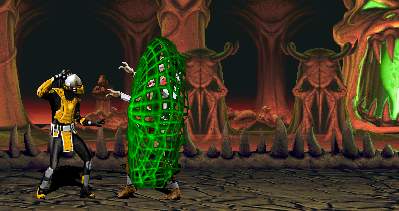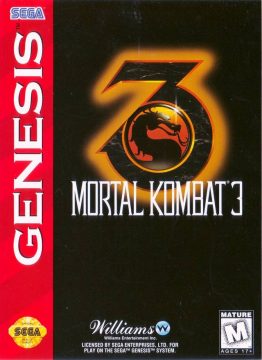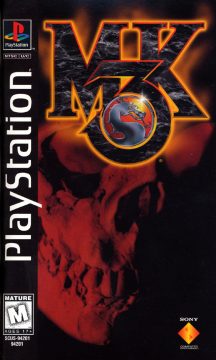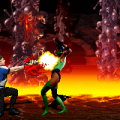- Mortal Kombat (Introduction)
- Mortal Kombat (1992)
- Mortal Kombat II
- Mortal Kombat 3
- Ultimate Mortal Kombat 3
- Mortal Kombat Trilogy
- Mortal Kombat 4
- Mortal Kombat Mythologies: Sub-Zero
- Mortal Kombat: Special Forces
- Mortal Kombat: Deadly Alliance
- Mortal Kombat Deception
- Mortal Kombat: Shaolin Monks
- Mortal Kombat Armageddon
- Mortal Kombat VS DC Universe
- Mortal Kombat (2011)
- Mortal Kombat X
- Mortal Kombat (Miscellaneous)
After the release of Mortal Kombat 2, the series had nowhere to go but up. Merchandise was being made, comics were being published, and talks of a major motion picture were in the air. With as much popularity as the series had, another sequel was inevitable. But this time around, instead of just taking the original Mortal Kombat and polishing it, a few new ideas were added in. Some of them worked, while others don’t work quite so well. There’s a new setting for all the violence to take place in, new gameplay mechanics, new secrets, new characters, and with that, a whole lot of new fatalities. Unfortunately, this is the point in the fighting game genre where Capcom and SNK were beginning to take some bold new steps, and MK3 doesn’t really do too much to change up the engine or the typical mechanics that make up an MK game.
It turns out Shao Kahn wasn’t quite dead, despite quite clearly turning into stone and exploding at the end of MK2. Not only that, but he has a new plan to conquer Earthrealm, this time skipping over the whole ‘tournament’ thing entirely. He has Shang Tsung resurrect his dead wife, Queen Sindel, somewhere in the Earthrealm. This somehow creates a loophole allowing Shao Kahn and his army to march straight in. Millions die instantly as Outworld and Earthrealm merge, and most of the survivors are killed by Shao Kahn’s army, including Johnny Cage. Raiden manages to protect the lives of the returning characters, but since he has no power in Outworld, he’s out of the fight. And so, the survivors have to fight their way to Shao Kahn, kill him once more, and save what’s left of the world.
This time around, there are sixteen playable characters, four more than MK2. Robot Smoke is also a secret challenger, unlockable for play by entering a code at the end of the game. Secret playable characters weren’t anything new at this point with the introduction of Street Fighter‘s Akuma, but this is the first time the MK series would do it. Nine of the characters are from the first two games, including the return of Kano and Sonya. One major exclusion, however, is Scorpion, Reptile, and the rest of the ninjas except for Sub-Zero. What happened was that Daniel Pesina, the actor who portrayed Johnny Cage and the male ninjas ended up being let go. (Urban legends claim this was due to him appearing in ad for MK competitor Bloodstorm, but this was shown to be false.) Because of this, Johnny Cage has left the roster, and John Turk now plays the role of Sub-Zero.
Unlike Mortal Kombat 2, which was basically the original game with a bit more polish to it, there are a few new additions to the old combat system this time around. Along with the now standard five button layout, you now also have a Run button. Holding this button down and moving toward the opponent will cause your character to break into a run towards their opponent. There’s a new meter under the health bar that ties into this, emptying whenever you run, before refilling a couple of seconds later. The whole run feature helps a lot to crank up the speed of the game, as well as giving it a much more offensive style of play. Hanging back and blocking a lot doesn’t help as much as it used to in MK2, since the opponent now has the ability to run right over and hammer on you. And with the new dial-a-combos, it’s that much easier to hammer on your opponents.
Dial-a-combos, which are rather common in 3D fighters, but pretty rare in 2D ones, are basically a string of buttons you hit in sequence to pull off an automatic combo. Some characters only have about three or four auto-combos to use, while others, like Sonya, have up to seven. Technically, there’s nothing stopping you from still using the traditional juggle combos that you would use in Mortal Kombat 2, although a couple of auto-combos will do just as much damage as one of the more complex custom combos. On one hand, the auto combos are a good way for anybody new to the game to get in some decent damage without learning the ins and outs of the combo system. The problem is that most of these combos can do around 30% damage to an opponent, so there’s a lot of temptation to abuse your standard chain combo instead of using a little creativity. For the most part, the game does play a lot faster than Mortal Kombat II ever did, which might be a good thing for some people, and an issue for others. Besides the new features, though, the controls and actual fighting mechanics are mostly similar, including the rather peculiar way the series handles special move inputs.
The single player mode isn’t quite as brutal as what you had to face in Mortal Kombat II, and in the early matches, one could almost say it’s fairly reasonable. For the first time, you can select from one of three levels of difficulty after you select a character, which determines how many opponents you have to face, as well as their skill level. Unfortunately, in good old Mortal Kombat tradition, once you get to the bosses, the game takes on that familiar level of challenge we’ve all grown to hate. Motaro, the sub-boss, takes after Goro and Kintaro before him by teleporting around the screen, blasting you with projectiles, resisting damage, and grabbing you a lot. What’s worse is that any projectiles you throw at him will bounce right off of him and into you, inflicting their full damage. This means you basically have to stay within arm’s reach, which is basically the worst possible spot to be when fighting him. The only small mercy is that he doesn’t have the teleport stomp attack Goro and Kintaro had, even if that doesn’t help much.
Shao Kahn is once again a cheap bastard who will spend equal amounts of time brutalizing you as he will mocking your pathetic efforts to beat the game. In fact, he has a new line where he lets you know that you do, in fact, suck. Thanks, Midway. And if he wasn’t bad enough before, now he can smack you with a hammer to stun you and leave you open for more pain. Beating him this time will give you a flashy animation of all the souls flooding out of his body, before his castle explodes. This is the last time we’re going to see Shao Kahn in any of the “main” MK games, so you’re probably going to start to miss him after seeing the other losers crawling for the final boss spot.
If one of the bosses ends up draining the credits out of you, there’s still a way to get something out of it, if you’re quick with the buttons. At the end of a game, you’re given a screen where you’re instructed to enter the ‘Ultimate Kombat Kode.’ The kode is made up of ten boxes, each containing a symbol that chat changes when you hit one of the buttons. If you manage to enter the correct code, which involves using both players’ buttons, you permanently unlock Robot Smoke as a playable character.
Kombat Kodes apply to the two player mode, as well, where you can enter them on the VS screen before a match starts. While these kodes have only six boxes, you only get a few seconds to enter them, so you’ll need the help of the other player to enter them in time. Some of these codes can have more subdued effects on the gameplay, like disabling throwing or giving both players unlimited run time. Others, like Randper Kombat, make it so both players are constantly morph into different characters throughout the fight. Some kodes grant the winner one match against one of the bosses or secret challengers, while others give hints to one of Midway’s pinball tables, which isn’t really helpful when you’re playing Mortal Kombat. There’s even a kode that lets you play an incredibly hard version of Galaxian, where the difficulty’s cranked so high you’ll probably only survive for about five seconds. The Kombat Kodes are a neat idea, although they’re a bit too much of a pain to memorize and actually enter to make them worthwhile.
Just like in Mortal Kombat 2, everybody gets two Fatalities, one friendship, and a Babality. Friendships are still worth it for Shao Kahn’s dumbfounded “Friendship! Friendship? AGAIN?” This time the Fatalities are a lot more over-the-top, so much so that they’re honestly kind of goofy. Sure, you’ve got some cool ones like Sheeva ripping the skin off of people, or Smoke dropping so many bombs it makes the entire planet explode ? which, in pure Mortal Kombat logic, means that not only does he win, there’s still a planet for him to fight the next match on. And then you’ve got more unusual finishing moves like Liu Kang dropping an MK1 cabinet onto the loser, or Jax growing 100 feet tall before stomping the opponent with his boot, Monty Python style. And that’s not even mentioning the number of Fatalities that end with the victim exploding into five legs, three ribcages, and two skulls. Sure, Mortal Kombat isn’t that easy to take seriously, anyway. But most of these Fatalities go from ‘brutal dismemberment of a beaten opponent’ to ‘Itchy & Scratchy would think what you just pulled looked stupid.’ Given the storyline involves the near extinction of the human race, “zany” just doesn’t really gel.
There’s also a new thing you can do at the end of the match, which, while not technically a finisher, leads into a brand new kind of -ality if you can pull it off. If both fighters have won one round each, the winner fighter can show his opponent mercy when it comes time to finish him. This will give the defeated player a sliver of life back to continue the fight, which while it probably won’t help him much, will at least give him a chance to win. You’re not doing this for the sportsmanship of it, though, you’re doing it for the new ?ality: The Animality. The Animality, when performed after a Mercy, has your fighter transform into some kind of animal and do something to murder the opponent. Some of these are fairly logical, like Sub-Zero turning into a polar bear. But then you’ve got Stryker turning into a T-Rex, or Sindel becoming a scorpion, and things start to get real goofy again.
It’s not often a fighting game has a post-apocalyptic scenario, and the change of scenery is rather nice. The first Mortal Kombat had a very Enter the Dragon feel to it, while the second one brought it to a dark, Conan-esque fantasy land with some Asian stylings. A lot of stages set in this game, however, are set in a major city, more than likely New York or Chicago, only there’s not a single person around except for the playable characters. There are still a few arenas set in Outworld, like a creepy church, but the stages set in the city are honestly a lot more interesting. The Pit returns for a third time, with the spikes being upgraded to a series of rotating blades, which is much cooler than plain old concrete. There’s also a minor gimmick with some of the stages where uppercutting the opponent will sometimes knock them through the ceiling, bringing you both to a different arena. It’s kind of a cool idea, except waiting for the transition to play out hurts the flow of the fight.
The game looks and sounds pretty decent, although It’s not quite as big a leap as it was from MK1 to MK2. Most of the backgrounds are made from pre-rendered 3D, which tends to clash with the digitized graphics. Some of the music is decent, like the organ piece for the Temple, but the music in the city stages has a more urban, painfully ’90s sound to it. There’s even a hip-hop remix of the Courtyard stage music from MK1. Steve Ritchie returns as the booming voice of Shao Kahn, although due to his tinnitus, this would sadly be the last time he would do any voice work until the PS2 era. Some of the male fighters tend to shout out this really wimpy sounding “Ow!” when you hit them, too, which really doesn’t help make the game any more dignified.
Overall, Mortal Kombat 3 is better than MK2 in some ways, while worse in others. The extra speed is nice, sure, but the new characters and their Fatalities are kind of lame. It doesn’t help that Scorpion, the guy people actually think of when they think of Mortal Kombat, isn’t actually in the game. The MK team would take some of these problems to heart, and end up fixing some of the issues people had, although this would end up running you about $50-$70 for another home version.
Just like the first two games, MK3 got ported to every console that mattered, and just like always, the ports would vary in quality. The Super Nintendo version isn’t so hot in the graphical and sound departments, with sprites that are a little under half the size of the arcade and some rather muffled sound. It plays pretty closely to the arcade, though, once you set the controls to something other than the default layout. What really makes this port interesting, however, are the cheat menus, of which there are three to unlock. Most of these replicate the kombat kodes without actually having to enter them at the VS screen, but you’ve also got options that let you use Motaro and Shao Kahn as playable characters in VS mode. And yes, they can be just as unfair once you have control over them. Also, there’s an option to enable pausing the game. Yes, you have to use cheats to pause the game! There’s also a team battle mode like in the port of MK2, if you enjoyed it there.
The Genesis version looks about the same as the Super Nintendo version, if a little more washed out. It plays pretty close to the SNES version, too, which means that despite its grainy look and poor sound quality, it still plays pretty well. Sadly, this game wasn’t ported by Probe like the first two games, so the soundtrack, done by somebody else this time. It’s closer in style to the arcade version, but isn’t anywhere as memorable or unique as what Matt Furniss could pull off. There’s a few hidden cheat menus here, too, although you don’t get as many options to play with, including no cheats that let you pause the game. You still have cheats to enable the bosses if you want to make your friends hate you, at least.
The Game Boy version is probably the worst choice, considering how cut down it is ? it only got nine of the fifteen playable characters of the arcade version. While the game generally runs faster than the Game Boy port of MK2, the controls feel much stiffer and harder to use, and you can forget about trying to do combos of any sort. On the plus side, you can unlock Robot Smoke as a playable character, if you’re a fan of him.
The Game Gear and Master System versions are based off the Game Boy version, which means they’ve got the same roster, along with the same issues. The controls are awful, so trying to pull off anything besides your basic moves probably won’t work. There’s also much less music in this port, and for whatever reason, no music plays during the actual fights at all. The AI feels especially brutal in this port, too, and there are no difficulty options to tone it down so you have any sort of chance. Not that this version is worth beating, anyway.
Tiger also gave this game their very special treatment, although this time it came for the R-Zone. This abominable obscurity is basically a controller and a monocle you strap around your head, to project an unidentifiable mass of red blotches directly onto your retina. The games come in the form of LCD screen modules, which are inserted in the monocle part. There was also an ordinary LCD handheld version, though.
One console MK3 never hit was the Jaguar, although it actually got pretty close. Apparently at one point there were plans to make the game a Jaguar exclusive, which would have been an arcade-perfect port programmed by Midway. While the game was presented at a few gaming expos, the Jaguar version was never released, and no known prototypes currently exist. It makes one pause to think, however, where Atari would have been if Mortal Kombat 3 had been their exclusive fighting game, and not Ultra Vortek.
Comparison Screenshots




